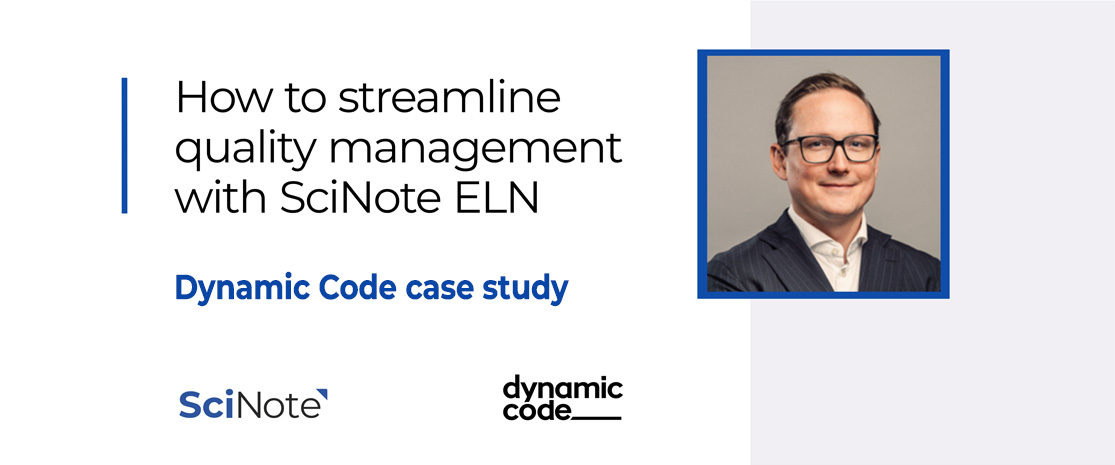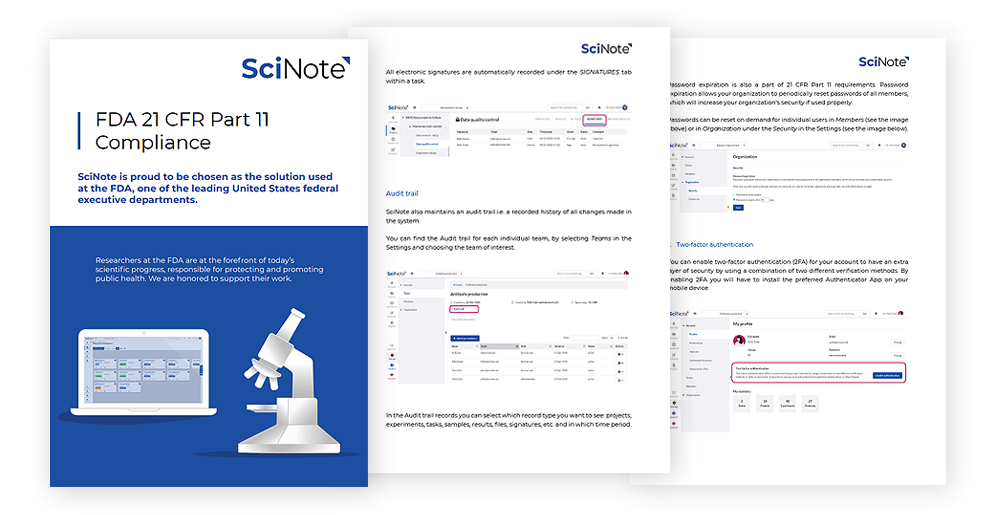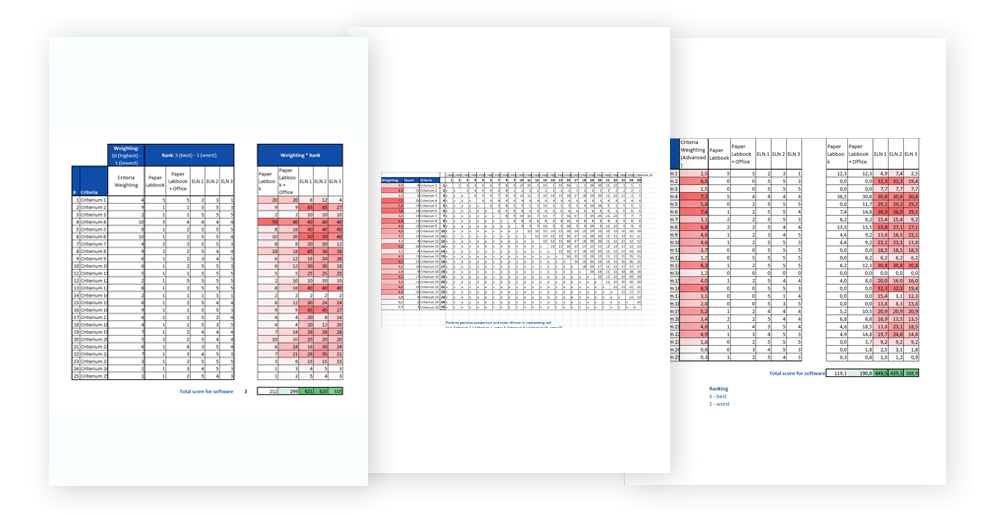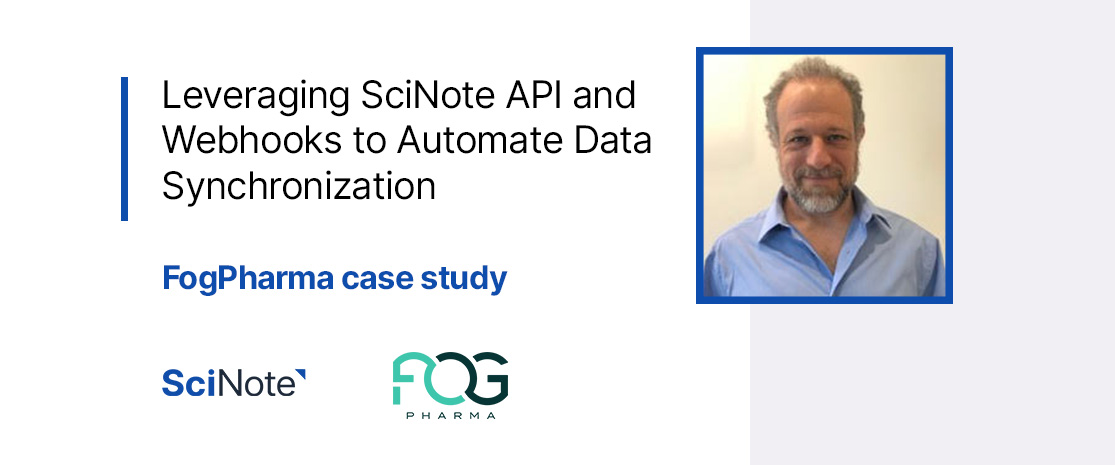How to streamline quality management with SciNote ELN – Dynamic Code case study
Here’s how Dynamic Code, a Sweden-based health and diagnostic test company, uses SciNote electronic lab notebook (ELN) to simplify its documentation approval process for regulatory requirements and to minimize administrative burden in the quality management process.
“Quality Management Systems (QMS) are mostly cumbersome and hard to work with. This creates an administrative burden. So if you can try to keep things outside of QMS and in a more workable system, for example like SciNote, it saves a lot of time both for the ones doing the lab work, and also the people approving the documentation.”
Dr. Magnus Refthammar, Head of R&D, Dynamic Code
Table of contents
- About the company
- The Challenge
- The Solution
- Key Takeaway
- Use dedicated systems designed for their purposes
- Supplement the Quality Management Process
- Selecting a digital tool for data infrastructure
- Adapting to regulatory requirements (and changes)
- Results
About the company
Dynamic Code is a Sweden-based company that has worked since 2011 to develop meaningful health and diagnostic tests based on advanced DNA technology. It provides an end-to-end digital healthcare chain through its platform.
The company offers an array of self-sampling laboratory tests, from disease diagnostics to wellness tests. Their tests are available in all major pharmacies in the Nordics, through their online store, and through health care providers. It also works closely with resellers, healthcare providers, and government agencies.

The Challenge
Dynamic Code has in place a quality management system (eQMS). However, the eQMS is cumbersome for everyday R&D use, creating additional administrative burden for those involved in laboratory experiments, and those who are responsible for documentation approval.
The need for a better data infrastructure became urgent with the In Vitro Medical Devices Regulation (IVDR) in EU officially taking effect in May 2022. With it, come higher demands of documentation, system compliance, and clinical validation studies.
The Solution
SciNote ELN was originally implemented to assist the company with digital documentation of its R&D work. The purpose was to ensure research notes can be easily stored and accessed, to facilitate research collaboration, and to improve the quality of documentation.
Now, the company uses the ELN platform to simplify its documentation approval process in accordance with IVDR, and to help minimize that administrative burden that IVDR poses to its team. SciNote’s intuitive interface, built-in audit trail, and compliance with FDA 21 CFR Part 11, makes it an ideal digital lab notebook to complement its existing eQMS and to improve the efficiency of the process.
Watch the full presentation on how an electronic lab notebook can help you meet lab compliance, improve efficiency, and bring operational benefits.
Key Takeaways
Use dedicated systems designed for their purposes
Dynamic Code utilizes both a barebone eQMS and an ELN in their data infrastructure set up for quality management and regulatory compliance. This allows it to keep as much of the process outside of the eQMS system that is cumbersome to use, while ensuring proper preparation of documentation.
- SciNote’s easy-to-use interface and intuitive project structure makes it fit for routine record-keeping by lab staff members. Its reports provide clear documentation that can be imported into the eQMS quickly.
- The eQMS is dedicated specifically for reviewing and approving protocols and reports prepared and generated using the electronic lab notebook’s report generator.
The result of this is a streamlined and efficient operation, so staff can focus on their own responsibilities.
As both the selected eQMS and ELN notebook are compliant with FDA and EU requirements for e-records, no additional evaluation is necessary to bridge the two systems, as both have built-in audit trail and activity tracking that will help monitor what changes are made by whom.
FDA 21 CFR Part 11 Compliance
SciNote supports electronic signatures, electronic witnessing, audit trails etc. Get SciNote’s 21 CFR Part 11 guide now.
Download now (PDF)Supplement the Quality Management Process
The company adopts the following to simplify their compliance documentation approval process.
1. Prepare the experiment protocol in the ELN
Lab personnel create the experiment protocol within a task in the ELN notebook. The protocol will contain the necessary information for relevant regulations (in this case, IVDR).
2. Import the protocol into the eQMS for approval
The prepared protocol is turned into a pdf report using the report generator.
The report is then imported into the eQMS for approval by the quality management team.
Note that at the moment, the protocol task is marked as “not started.”
3. Perform the approved protocol; document results in SciNote
Once approved in the eQMS, the protocol is ready to be performed. The experiment is tracked with results uploaded directly into the ELN platform. Once completed, the protocol task is marked as “done” and a new report is generated from the electronic lab notebook.
4. Import the new report in the eQMS for final approval
The new report is imported into the eQMS with relevant documentation attached. The report is then reviewed and approved in the eQMS.
Selecting a digital tool for data infrastructure
The team from Dynamic Code shared the following advice when it comes to selecting a digital tool for a data infrastructure with the goal of meeting regulatory requirements.
- Look for ones that already have built-in features to meet lab compliance (such as FDA 21 CFR Part 11, GxP, or Quality Management requirements).
- Test the systems and talk to reference customers will help minimize the risk and allow you to understand whether a system is a good fit to your process.
- Have a good understanding of what the tool can achieve, and what your intended goal is. This will help you set up the documentation approval structure properly without too many changes and adjustments down the road.
- Start planning early.
- Ensure the system is able to keep good track of file versions (e.g. technical files)
Are you evaluating electronic lab notebooks?
Download the free ELN evaluation Excel template by NEUWAY Pharma
Download now (Excel)Adapting to regulatory requirements (and changes)
The team started the process relatively late, so their top advice is that do not underestimate the impact of regulatory requirements (or changes in regulatory requirements). It will take money and it will take time. Start early, and start in time.
- Use lawyers and consultants to interpret regulatory requirements, but also have a good understanding of the regulations yourself. Make sure you grasp the big picture.
- Explore the materials available through government agencies. They usually provide a lot of resources for adapting to requirements.
- The process is incremental – have a plan. Be prepared for the money and resources it takes to be compliant.
- Look at the business case for your products and really think about it before you start the journey. Thoroughly understand what your customers’ demand.
Start early with a digital solution. You will regret it if you don’t do it digital from the beginning.
Results
SciNote helps Dynamic Code improve its efficiency in its documentation approval and quality management processes by providing an intuitive, easy-to-use interface for lab staff to prepare necessary records for lab compliance. It allows the quality management team to focus on only documentation they need to review and approve. It minimizes the administrative burden necessary to stay compliant with demanding regulatory requirements.
Schedule a Q&A session with us to discover all the features that SciNote ELN can offer
Book your informative meeting now and avoid missing out on crucial information.
Book a meeting

















